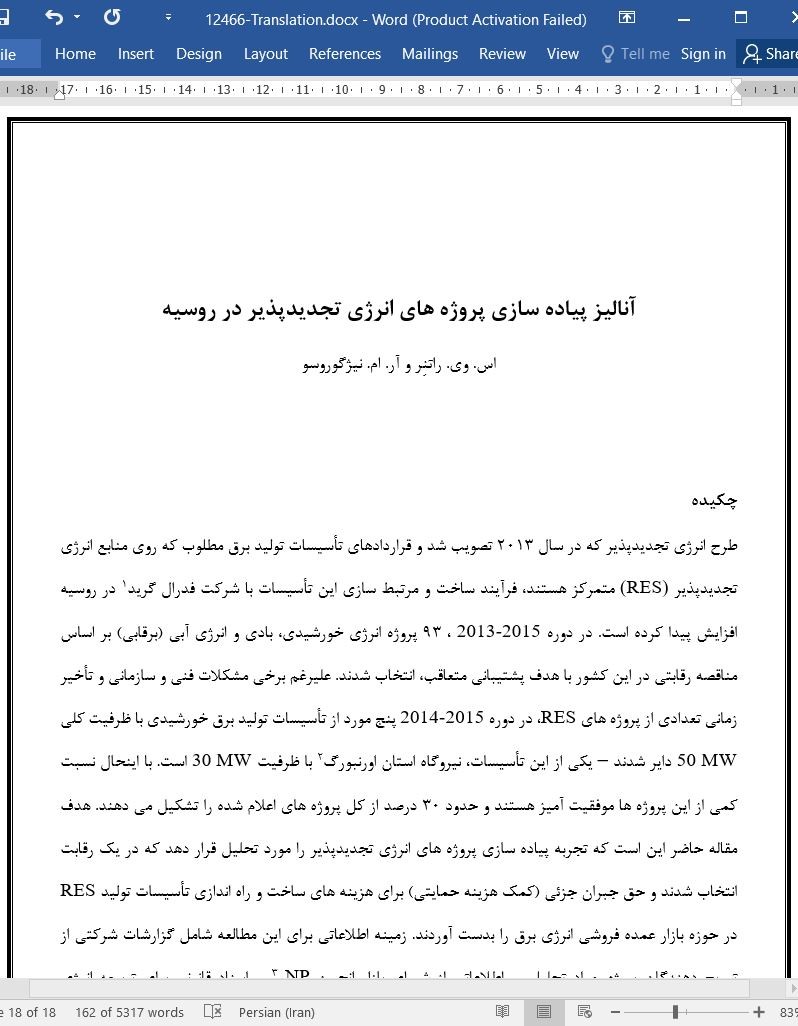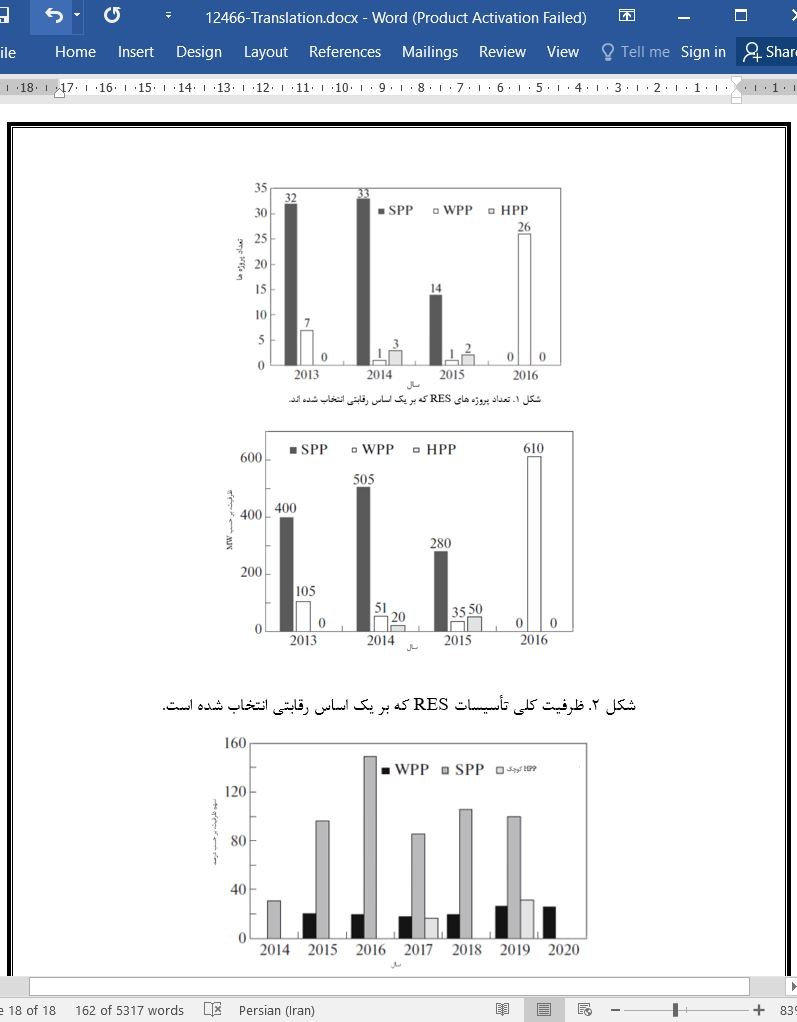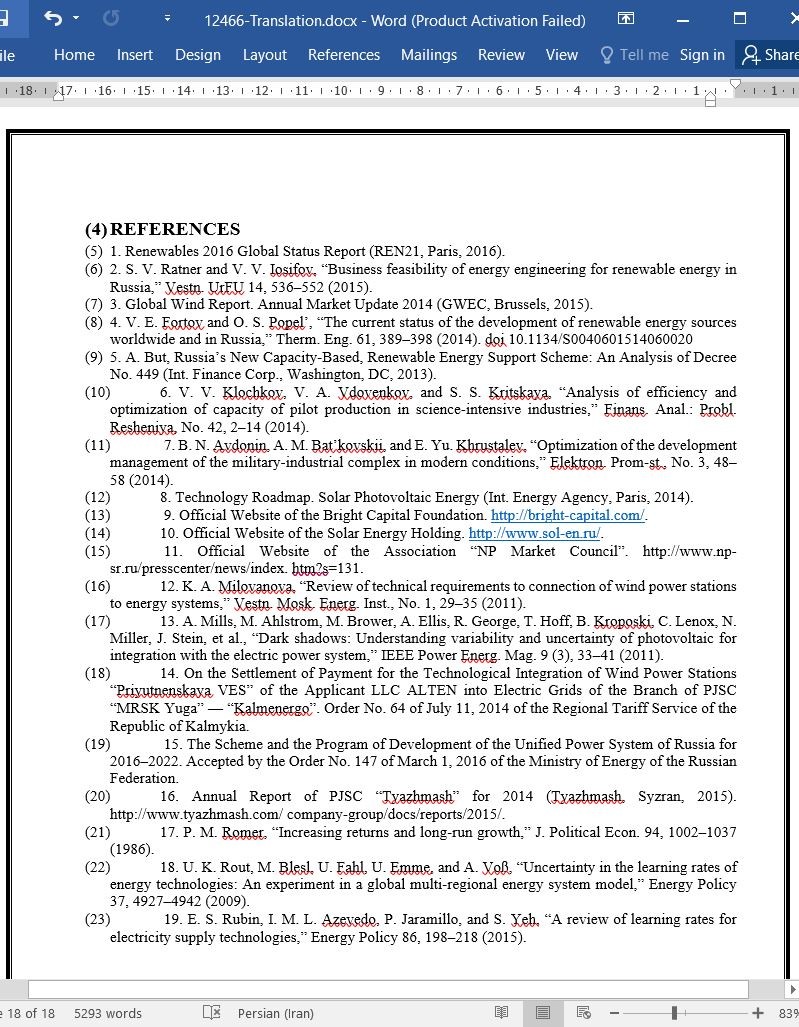
دانلود مقاله آنالیز پیاده سازی پروژه های انرژی تجدیدپذیر در روسیه
چکیده
طرح انرژی تجدیدپذیر که در سال 2013 تصویب شد و قراردادهای تأسیسات تولید برق مطلوب که روی منابع انرژی تجدیدپذیر (RES) متمرکز هستند، فرآیند ساخت و مرتبط سازی این تأسیسات با شرکت فدرال گرید در روسیه افزایش پیدا کرده است. در دوره 2013-2015 ، 93 پروژه انرژی خورشیدی، بادی و انرژی آبی (برقابی) بر اساس مناقصه رقابتی در این کشور با هدف پشتیبانی متعاقب، انتخاب شدند. علیرغم برخی مشکلات فنی و سازمانی و تأخیر زمانی تعدادی از پروژه های RES، در دوره 2014-2015 پنج مورد از تأسیسات تولید برق خورشیدی با ظرفیت کلی 50 MW دایر شدند – یکی از این تأسیسات، نیروگاه استان اورنبورگ با ظرفیت 30 MW است. با اینحال نسبت کمی از این پروژه ها موفقیت آمیز هستند و حدود 30 درصد از کل پروژه های اعلام شده را تشکیل می دهند. هدف مقاله حاضر این است که تجربه پیاده سازی پروژه های انرژی تجدیدپذیر را مورد تحلیل قرار دهد که در یک رقابت انتخاب شدند و حق جبران جزئی (کمک هزینه حمایتی) برای هزینه های ساخت و راه اندازی تأسیسات تولید RES در حوزه بازار عمده فروشی انرژی برق را بدست آوردند. زمینه اطلاعاتی برای این مطالعه شامل گزارشات شرکتی از ترویج دهندگان پروژه، مواد تحلیلی و اطلاعاتی از شورای بازار انجمن NP ، و اسناد قانونی برای توسعه انرژی تجدیدپذیر می باشد. مبنای روش شناختی این مطالعه، نظریه ای از منحنی های یادگیری است که فرض میکند صرفه جویی در هزینه های تولید محصولات فرا-فن به نرخ رشد تولید (صرفه جویی به مقیاس) و کسب تجربه تولید (یادگیری بصورت عملی) بستگی دارد. ما در این مطالعه عواملی را شناسایی کرده ایم که تأثیرات مثبت و منفی بر روی پیاده سازی پروژه های RES دارند. ما بهبود ابزارهای سنجش پیشرفت (پیش بردن) در توسعه انرژی تجدیدپذیر در روسیه را در تطابق با شرایط اجتماعی-اقتصادی فعلی پیشنهاد کرده ایم.
روسیه بعنوان کشوری با یک سیستم انرژی پیشرفته و یکی از پیشگامان جهانی در زمینه ذخایر انواع اصلی منابع سوخت اولیه، چه در کوتاه مدت و چه در میان مدت با مشکل مطمئن شدن از امنیت انرژی از طریق توسعه منابع انرژی تجدیدپذیر مواجه نخواهد شد. با اینحال در 15 سال پیش، بخش های انرژی تجدیدپذیر همچون انرژی های خورشیدی و بادی که از لحاظ تکنولوژیکی پیشرفت کاملی داشته اند، به یک تجارت فرا-فن قوی با سرمایه گذاری های چند میلیارد دلاری، و به موضوعی برای رقابت در بین مناطق مختلف و حتی در بین کشورها تبدیل شده اند. حجم سرمایه گذاری بر روی پروژه های خورشیدی در سال 2015 حدود 161 میلیارد دلار (آمریکا) و حجم سرمایه گذاری بر روی پروژه های بادی حدود 100 میلیارد دلار (آمریکا) بوده است [1]. طبق برآورد مؤلفان این مقاله بر اساس مرور بخش ها و گزارشات شرکتی بزرگترین تولیدکنندگان مدول های فتوولتاییک (نور ولتایی) و ژنراتورهای بادی، بازار جهانی برای مدول های فتوولتاییک در سال 2015 برابر با 72 میلیارد دلار (آمریکا) بود که این نسبت به 2 سال قبل، بیش از 2.6 برابر بیشتر است [2]. تولید و سرویس دهی کلی ژنراتورهای بادی نزدیک به 80 میلیارد دلار (آمریکا) بود که در مقایسه با سال 2013 بیش از دو برابر افزایش پیدا کرده بود [2]. اثرات افزاینده از توسعه RES نه تنها به مهندسی قدرت (انرژی) گسترش می یابد بلکه بخش هایی مانند مهندسی برق، مهندسی مواد، و تولید عناصر نادر خاکی، حمل و نقل، فناوری های اطلاعات و ارتباطات، ساختمان سازی، مصالح ساختمانی و غیره را نیز در بر می گیرد؛ اینها همچنین محرک هایی برای فعالیت ابتکاری شرکت های انرژی هستند و تحقیق و توسعه را ترغیب می کنند.
نتیجه گیری ها
(1) تحقق تکامل تکنولوژی و کارایی اقتصادی اَشکالی از انرژی تجدیدپذیر (تولید خورشیدی، بادی، و انرژی آبی کوچک) که از سوی دولت حمایت می شوند، امروزه توسط حدود اجرایی کردن تأسیسات و ارتباط آنها با شبکه انرژی، محدود می شوند.
(2) تلاش برای توسعه تکنولوژی های ابتکاری و ایجاد تولید فرا-فن رقابتی جدید در یک مقیاس محدود، بدون افزایش توسعه در بازارهای داخلی یا خارجی، طبق فراهم سازی های اصلی نظریه اقتصادی توسعه ابتکاری دارای احتمال خیلی پایینی برای پیاده سازی موفقیت آمیز است و شواهد آنرا در تجربه پروژه های RES در روسیه می توانیم ببینیم.
(3) در زمینه جاری، به نظر می رسد امیدبخش ترین شیوه تصحیح مکانیزم موجود حمایت دولت از انرژی تجدیدپذیر، افزایش حدود ظرفیت نصب شده تأسیسات تولید از یک نوع یکسان (با آماده ترین پایه تولید برای توسعه تکنولوژی های جدید) از طریق کاهش حدود ظرفیت نصب شده نوع دیگری از تأسیسات تولید (با حداقل پایه تولید آماده شده و مقاومت تکنولوژیکی) باشد.
Abstract
With the enactment in 2013 of a renewable energy scheme by contracting qualified power generation facilities working on renewable energy sources (RES), the process of construction and connection of such facilities to the Federal Grid Company has intensified in Russia. In 2013–2015, 93 projects of solar, wind, and small hydropower energy were selected on the basis of competitive bidding in the country with the purpose of subsequent support. Despite some technical and organizational problems and a time delay of some RES projects, in 2014–2015 five solar generating facilities with total capacity of 50 MW were commissioned, including 30 MW in Orenburg oblast. However, the proportion of successful projects is low and amounts to approximately 30% of the total number of announced projects. The purpose of this paper is to analyze the experience of implementation of renewable energy projects that passed through a competitive selection and gained the right to get a partial compensation for the construction and commissioning costs of RES generating facilities in the electric power wholesale market zone. The informational background for the study is corporate reports of project promoters, analytical and information materials of the Association NP Market Council, and legal documents for the development of renewable energy. The methodological base of the study is a theory of learning curves that assumes that cost savings in the production of high-tech products depends on the production growth rate (economy of scale) and gaining manufacturing experience (learning by doing). The study has identified factors that have a positive and a negative impact on the implementation of RES projects. Improvement of promotion measures in the renewable energy development in Russia corresponding to the current socio-economic situation is proposed.
Russia, as a country with a developed energy system and a world leader in the deposits of basic types of primary fuel resources, will not face—either in the short or medium term—a problem of ensuring energy security through the development of renewable energy sources. However, in the last decade and a half, the most technologically mature sectors of renewable energy, such as solar and wind, have turned into a powerful high-tech business with a multibillion dollar investment, being the subject of competition both between separate regions and whole countries. The volume of investment in solar projects in 2015 amounted to approximately $161 billion USD and that in wind projects amounted to $100 billion USD [1]. According to the authors' estimates made on the basis of sectoral reviews and corporate reports of the largest manufacturers of photovoltaic modules and wind generators1, the global market for photovoltaic modules in 2015 was $72 billion USD, which is more than 2.6 times higher than 2 years ago [2]. The global production and service of wind generators was close to $80 billion USD and increased in comparison with 2013 more than two times [2]. Multiplicative effects from the development of RES extend not only to power engineering but also to such sectors as electrical engineering, power electronics, metallurgy, and production of rare earth elements, transport, information and telecommunication technologies, building, construction materials, etc. and they are also drivers of innovative activity for energy companies, stimulating research and development.
CONCLUSIONS
(1) Achievement of technological maturity and economic efficiency of the state-supported forms of renewable energy (solar and wind generation, small hydropower) today is constrained by limits on putting facilities into operation and their connection to the power grid.
(2) An attempt to develop innovative technologies and create new competitive high-tech production on a limited scale, without the enhanced expansion on the domestic or foreign markets, according to the main provisions of the economic theory of innovative development, has a very low probability of successful implementation, as evidenced by the experience of RES projects in Russia.
(3) In the present context, the most promising way to correct the existing mechanism of state support of renewable energy seems to be increasing the installed capacity limits of generating facilities of the same kind (with the most prepared production base for the development of new technologies) by reducing the installed capacity limits of generating facilities of another kind (with the least prepared production base and technological strength).
چکیده
مکانیزم های حمایت دولت از توسعه انرژی تجدیدپذیر در روسیه
تحلیل یک مکانیزم ترویج در انرژی تجدیدپذیر بر یک اساس بار الکتریکی ظرفیت
تحلیل موانع توسعه برنامه های انرژی تجدیدپذیر که از روش منحنی های یادگیری استفاده میکنند
نتیجه گیری ها
منابع
Abstract
MECHANISMS OF STATE SUPPORT OF RENEWABLE ENERGY DEVELOPMENT IN RUSSIA
ANALYSIS OF A PROMOTION MECHANISM IN THE RENEWABLE ENERGY ON A CAPACITY CHARGE BASIS
ANALYSIS OF THE DEVELOPMENT BARRIERS OF THE RENEWABLE ENERGY PROGRAMS USING A LEARNING CURVES METHODOLOGY
CONCLUSIONS
REFERENCES
- اصل مقاله انگلیسی با فرمت ورد (word) با قابلیت ویرایش
- ترجمه فارسی مقاله با فرمت ورد (word) با قابلیت ویرایش، بدون آرم سایت ای ترجمه
- ترجمه فارسی مقاله با فرمت pdf، بدون آرم سایت ای ترجمه



